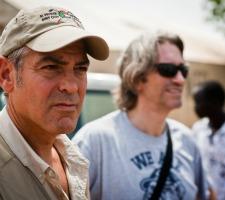BROOKE GLADSTONE:
Last October, movie star George Clooney was in the genocide-ravaged country of Sudan with human rights activist John Prendergast. They wondered, was it possible to track things like troop movements and human rights violations from the sky?
Within weeks, and with funding from Not On Our Watch, an organization Clooney sits on the board of, the Satellite Sentinel Project was launched and was photographing what was going on on the ground in Sudan. The project can capture pictures in near-real time of areas of Sudan that are too remote or too dangerous for journalists to get to.
The project is the first of its kind. Jonathan Hutson is director of communications for the Enough Project and the Satellite Sentinel Project.
JONATHAN HUTSON:
The Satellite Sentinel Project's principal aims are to prevent a return to full-scale war between Sudan and South Sudan, and also to deter mass atrocities by creating liabilities for those who might commit war crimes. If you do commit mass atrocities, we'll document that and make it public, and you could wind up standing trial for those war crimes.
BROOKE GLADSTONE:
So how does it work? Where does it get its information?
JONATHAN HUTSON:
So I tracked down an interview, confidential sources on the ground and feed these on-the-ground reports from eyewitnesses to Nathaniel Raymond and his team — they call themselves spy kids — at the Harvard Humanitarian Initiative.
And then that team uses commercial satellites, and they tell the cameras what areas of interest to shoot on a daily basis.
BROOKE GLADSTONE:
These are Harvard undergrads and Harvard grads. I'm still wondering what exactly it is they're seeing that says, uh oh, something bad is afoot down there?
JONATHAN HUTSON:
A good case, example is one of our most recent reports showed a massive wall of armor, and it was headed toward a rebel stronghold in a place called Kurmuk. We saw close air support from six attack helicopters, we saw infantry, troop carriers, we saw mobile artillery, and we were able to give advance warning to the citizens of Kurmuk.
BROOKE GLADSTONE:
So in that case, you were actually able possibly to prevent a fair number of deaths. In other cases, you are able to track from the sky, atrocities that may have already occurred and been unreported, right?
JONATHAN HUTSON:
Yeah. Our biggest report to date came on July 14. We reported the first three of what we've now found are eight mass graves.
BROOKE GLADSTONE:
And you also check out burn patterns on the ground?
JONATHAN HUTSON:
We looked for example at evidence of looting and razing. Our satellites saw a third of the civilian infrastructure in the town of Abyei was burned to the ground.
BROOKE GLADSTONE:
I also read that you pick up clues about roads being improved. Roads that are improved that are not oil-related suggest that it's the military at work.
JONATHAN HUTSON:
The only reason to improve a road in these remote, rural areas of Sudan is either if you're drilling for oil and there was no oil drilling in the area, or if you're preparing a road for what we call a tank run, an invasion. They were actually paving the roads and building them up to become all-weather roads. And that allows to correctly predict one month in advance, exactly how Sudan would invade Abyei a month later.
BROOKE GLADSTONE:
You're assembling evidence for war trials, but you're also assisting journalists.
JONATHAN HUTSON:
One thing we do is provide journalists with satellite imagery, as well as summaries of our eyewitness reports. And we also work with people on the ground of the Nuba Mountains who are gathering information and helping them, training them how to work with journalists who might come in.
BROOKE GLADSTONE:
You have different standards for how you handle information than say The New York Times does, right?
JONATHAN HUTSON:
For example, The New York Times ran this story showing a girl who was a bombing survivor and they gave her name and her age and her home village and a lot of other identifying information about her. We interviewed that same girl.
We thought that for reasons of security, there was no reason to actually give the details about her actual name. The New York Times, you know, they were being true to journalistic standards. It's just that we actually are gathering evidence to a standard that could one day be introduced at a war crimes trial in The Hague.
BROOKE GLADSTONE:
Are you close to assembling enough evidence to bring a trial there?
JONATHAN HUTSON:
We have already submitted to the UN Security Council and to the International Criminal Court, evidence of the government of Sudan's war crimes. And we've also submitted evidence of mass killings and mass graves.
BROOKE GLADSTONE:
Are they acting on it?
JONATHAN HUTSON:
About five hours after we released our July 14 report finding the first three of the mass graves, the UN Security Council went into closed session. And the US, the UK and France were pressing for action, and that was blocked largely by China and Russia.
BROOKE GLADSTONE:
Tell me how you make use of media to get your messages out.
JONATHAN HUTSON:
In the case of the looting of Abyei, we were able within hours to issue press releases, and we got hundreds of major media mentions in print, broadcast, and online media. The point is not that, you know, we're telling President Obama or the UN Security Council things that they don't already know through their satellite, but we're telling you the public: here's the information now.
You can see it, and you can pressure policymakers around the globe to respond more quickly and effectively.
BROOKE GLADSTONE:
Jonathan, thank you very much.
JONATHAN HUTSON:
Thank you, Brooke.
BROOKE GLADSTONE:
Jonathan Hutson is Director of Communications for the Enough Project and the Satellite Sentinel Project.
